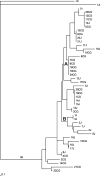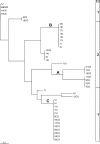An assessment of the genetic diversity of Leishmania infantum isolates from infected dogs in Brazil
- PMID: 22556077
- PMCID: PMC3335683
- DOI: 10.4269/ajtmh.2012.11-0300
An assessment of the genetic diversity of Leishmania infantum isolates from infected dogs in Brazil
Abstract
Correlations between the genetic diversity of Leishmania infantum (syn. L. chagasi) isolates and their respective geographic origins support the theoretic assumption that visceral leishmaniasis probably originated in the Old World. Because dogs are widely considered to be the main reservoir of this disease, the present study aimed to investigate the degree of genetic divergence among 44 leishmanial canine isolates from two Brazilian cities, Jequié and Campo Grande, located approximately 2,028 km from each other. We hypothesized that a low degree of genetic divergence would be observed among these isolates. In fact, statistical analyses found no significant differences between the isolates using both random amplified polymorphic DNA and multilocus microsatellite typing genotyping techniques with three and seven markers, respectively. These findings provide support for the recent introduction of L. infantum into the New World.
Figures



Similar articles
-
Genetic homogeneity among Leishmania (Leishmania) infantum isolates from dog and human samples in Belo Horizonte Metropolitan Area (BHMA), Minas Gerais, Brazil.Parasit Vectors. 2015 Apr 15;8:226. doi: 10.1186/s13071-015-0837-y. Parasit Vectors. 2015. PMID: 25889010 Free PMC article.
-
Spatial distribution and population genetics of Leishmania infantum genotypes in São Paulo State, Brazil, employing multilocus microsatellite typing directly in dog infected tissues.Infect Genet Evol. 2013 Aug;18:48-59. doi: 10.1016/j.meegid.2013.04.031. Epub 2013 May 9. Infect Genet Evol. 2013. PMID: 23665466
-
First insights into the genetic diversity and origin of Leishmania infantum in Mont Rolland (Thiès region, Senegal).Microbes Infect. 2016 Jun;18(6):412-420. doi: 10.1016/j.micinf.2016.02.003. Epub 2016 Mar 3. Microbes Infect. 2016. PMID: 26945844
-
Canine leishmaniasis: epidemiological risk and the experimental model.Trends Parasitol. 2002 Sep;18(9):399-405. doi: 10.1016/s1471-4922(02)02347-4. Trends Parasitol. 2002. PMID: 12377257 Review.
-
Geographic distribution and spatial analysis of Leishmania infantum infection in domestic and wild animal reservoir hosts of zoonotic visceral leishmaniasis in Iran: A systematic review.J Vector Borne Dis. 2018 Jul-Sep;55(3):173-183. doi: 10.4103/0972-9062.249125. J Vector Borne Dis. 2018. PMID: 30618442
Cited by
-
Evaluating the accuracy of molecular diagnostic testing for canine visceral leishmaniasis using latent class analysis.PLoS One. 2014 Jul 30;9(7):e103635. doi: 10.1371/journal.pone.0103635. eCollection 2014. PLoS One. 2014. PMID: 25076494 Free PMC article.
-
Genetic variability of Leishmania (Leishmania) infantum causing human visceral leishmaniasis in the Southeastern Brazil.Rev Inst Med Trop Sao Paulo. 2023 Oct 20;65:e55. doi: 10.1590/S1678-9946202365055. eCollection 2023. Rev Inst Med Trop Sao Paulo. 2023. PMID: 37878972 Free PMC article.
-
Leishmania donovani P23 protects parasites against HSP90 inhibitor-mediated growth arrest.Cell Stress Chaperones. 2015 Jul;20(4):673-85. doi: 10.1007/s12192-015-0595-y. Epub 2015 May 7. Cell Stress Chaperones. 2015. PMID: 25948161 Free PMC article.
-
Leishmania infantum Genetic Diversity and Lutzomyia longipalpis Mitochondrial Haplotypes in Brazil.Biomed Res Int. 2016;2016:9249217. doi: 10.1155/2016/9249217. Epub 2016 Mar 29. Biomed Res Int. 2016. PMID: 27119085 Free PMC article.
-
Genetic homogeneity among Leishmania (Leishmania) infantum isolates from dog and human samples in Belo Horizonte Metropolitan Area (BHMA), Minas Gerais, Brazil.Parasit Vectors. 2015 Apr 15;8:226. doi: 10.1186/s13071-015-0837-y. Parasit Vectors. 2015. PMID: 25889010 Free PMC article.
References
-
- Tesh RB. Control of zoonotic visceral leishmaniasis: is it time to change strategies? Am J Trop Med Hyg. 1995;52:287–292. - PubMed
-
- World Health Organization Wkly Epidemiol Rec. 2002;77:365–372. - PubMed
-
- Lainson R, Rangel EF. Lutzomyia longipalpis and the eco-epidemiology of American visceral leishmaniasis, with particular reference to Brazil: a review. Mem Inst Oswaldo Cruz. 2005;100:811–827. - PubMed
-
- Marzochi MC, Marzochi KB. Tegumentary and visceral leishmaniases in Brazil: emerging anthropozoonosis and possibilities for their control. Cad Saude Publica. 1994;10((Suppl 2)):359–375. - PubMed
-
- Monteiro P, Lacerda M, Arias J. Controle da leishmaniose visceral no Brasil. Rev Soc Bras Med Trop. 1994;27:27.
Publication types
MeSH terms
Substances
LinkOut - more resources
Full Text Sources
Miscellaneous

